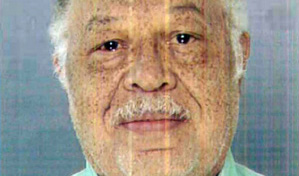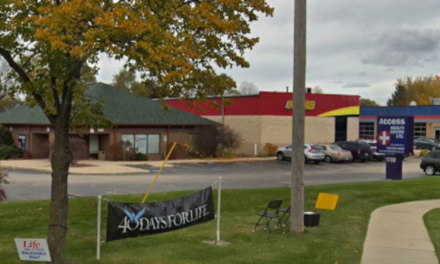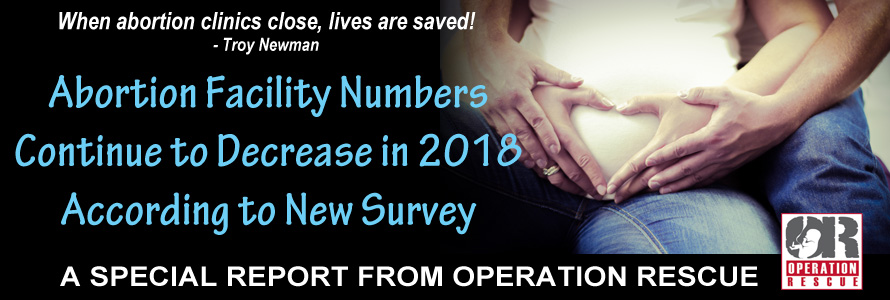
An Operation Rescue Special Report (Part One of Two)
[Note: This report has been updated with revised numbers for 2018.]
By Cheryl Sullenger
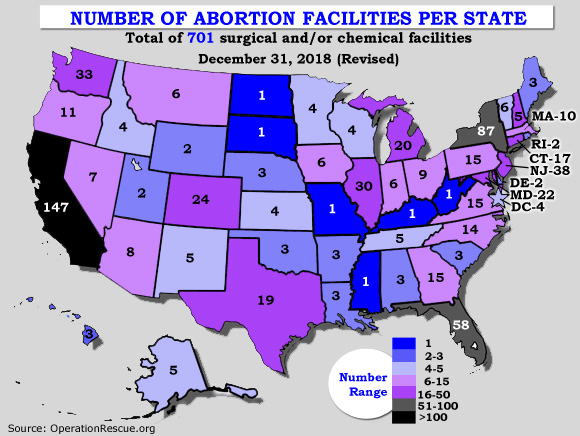
The number of abortion clinics in America continued to decline in 2018, following a trend that has seen an overall decrease of 155 abortion facilities since 2012.
Overall, in 2018, 40 abortion facilities closed or no longer qualify as abortion clinics.

Today, there are a total of 701 abortion centers left in America – three fewer than there were at the end of 2017.
That total includes 471 facilities that conduct surgical abortions – down dramatically from the high-water mark of 2,176 surgical facilities documented in 1991. This represents a massive 78 percent decrease in the number of surgical abortion facilities over the past 27 years.
The data was compiled by Operation Rescue, which conducted a survey of all abortion facilities in the U.S. from November 26 through December 14, 2018.
Each year, Operation Rescue conducts a nationwide survey that involves contacting each abortion business in the U.S. The information gathered about the abortion clinics and their practices represents the most accurate data available.
Operation Rescue defines “abortion clinics” as those businesses that conduct abortions outside a hospital setting. There are two categories of abortion clinics:
- Surgical Abortion Clinics: These offices conduct surgical abortions. Almost always, surgical facilities also distribute abortion-inducing drugs.
- Medical Abortion Clinics: These offices supply abortions through the administration of drugs (pills) or other chemical means. They do not conduct surgical abortions.

At the end of 2018, there were 19 fewer surgical abortion clinics than at the same time last year. Thirty-two surgical abortion facilities closed or no longer meet the definition of a surgical abortion facility.
Clinics that offered abortion drugs only, such as abortion pills or other chemical means, increased in number by 16 facilities to a total of 230. However, 12 of those added clinics were not new. They were surgical facilities that reduced services to provide only medical abortions. In 2018, eight medical abortion facilities closed permanently.
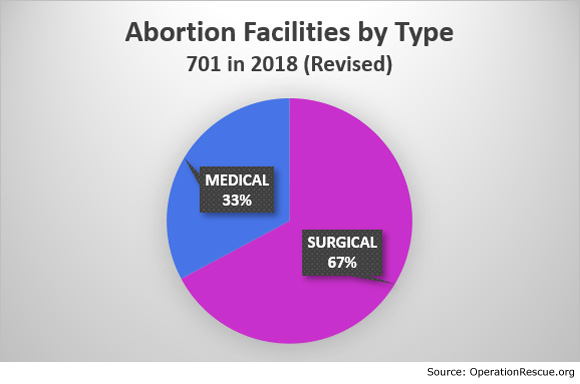
Although the number of medical abortion facilities has increased, they merely occupy a larger piece of an ever-shrinking pie. Unable or unwilling to meet new surgical facility safety regulations, some have resorted to dropping surgical abortions as perhaps their only means of staying open – especially in states that do not regulate medical abortion clinics or that allow non-physicians to dispense the drugs.
Planned Parenthood
Planned Parenthood, now under the direction of new CEO Leana Wen, continues to undergo a reorganization of facilities and staff, while attempting to expand abortions primarily through the use of abortion drugs.
There are currently 358 Planned Parenthood facilities that conduct abortions. Of those, 160 are surgical abortion facilities and 198 offer pill abortions. However, many of Planned Parenthood’s pill clinics only offer abortions on a limited or part-time basis.
While Planned Parenthood’s surgical facility numbers remain unchanged in 2018, abortion pill facilities have increased by 11 over 2017 numbers – a modest increase despite almost-desperate efforts to expand abortion availability.

Nevertheless, the few additional Planned Parenthood abortion facilities do not represent an increase in total clinic numbers, which continue to decline nationwide.
Planned Parenthood locations now represent 51 percent of all abortion facilities in the U.S., gaining two percent in 2018.
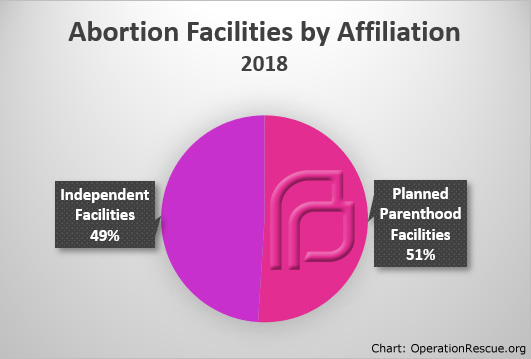
But that does not mean that Planned Parenthood is doing more abortions than the 49 percent of clinics that are not affiliated with them. On the contrary, a report released in November 2018 by the Abortion Care Network claims that independent abortion facilities conduct 60 percent of all abortions in the U.S., while Planned Parenthood facilities account for only 35 percent.
“We cannot afford to forget about the non-Planned Parenthood abortion facilities because they do the vast majority of abortions,” said Newman. “Independent clinics generally tend to be for-profit businesses, and that motivates them to conduct as many abortions as possible.”
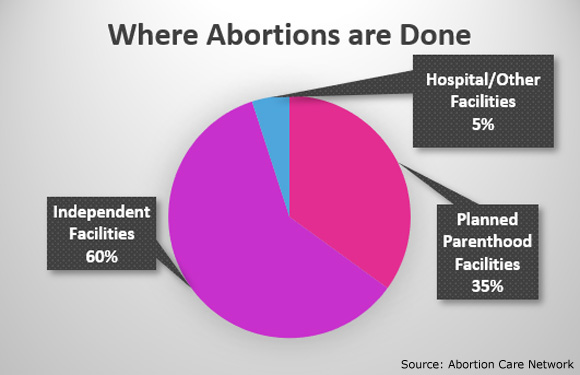
Closed Clinics Mean Fewer Abortions
According to the Center for Disease Control’s recent abortion surveillance report, the number of abortions decreased by 2 percent in 2015, the latest year for which statistics are available. The abortion rate (number of abortions per 1,000 women aged 15–44 years) and the abortion ratio (number of abortions per 1,000 live births) also decreased by 2 percent, according to the CDC.
Operation Rescue’s 2015 abortion facility survey report showed that the number of abortion facilities decreased by about the same amount (2 percent) in 2015.
This demonstrates that a direct correlation exists between the number of abortion facilities and the number of abortions.
“When abortion clinics close, lives are saved,” said Operation Rescue President Troy Newman. “Our data, when compared to the CDC’s data, is compelling evidence of that fact. Based on that, we can expect to see abortion numbers continue to decline.”
Reasons for Closures
A number of factors have led to the closure of abortion clinics in America. Some facilities that have not been able to compete in an ever-shrinking abortion market have been forced to shut down for economic reasons.
Other factors that contribute to clinic closures include:
- Successful pro-life activism.
- New state laws.
- Failure to comply with existing laws and safety regulations.
- Loss of tax funding in several states.
- Loss of abortion provider.
- Unwillingness of landlords to continue leases with abortion businesses.
Notable Closures in 2018
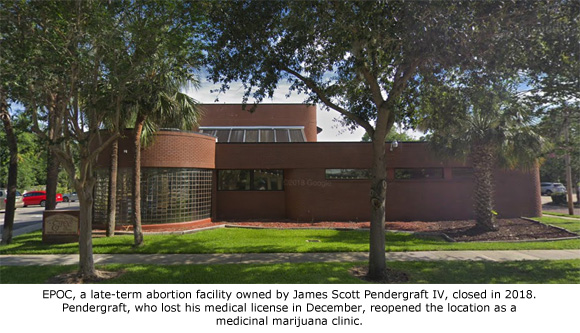
There were several noteworthy facilities that closed or halted abortion services in 2018.
EPOC, located in Orlando, Florida, was once a high-volume abortion facility specializing in late-term abortions owned and operated by abortionist James Scott Pendergraft, IV. It closed after the Florida Medical Board made it clear that it intended to revoke Pendergraft’s medical license after six suspensions and, finally, an arrest and conviction for dealing illicit drugs in South Carolina, where he was also conducting illegal abortions out of his van.
American Family Planning in Pensacola, Florida was shut down by the state for licensing issues. It is affiliated with the notorious and disgraced New Jersey abortionist Steven Chase Brigham.
Two Planned Parenthood abortion facilities in Kansas City and Columbia, Missouri were forced to halt abortions. New licensing regulations and a failed health inspection – where authorities found mold in the suction abortion machine – contributed ceasing abortions at the Columbia facility. These facilities are significant because they were part of Planned Parenthood’s failed attempt to expand abortions in Missouri, which is now left with one abortion clinic in the entire state.
Women’s Center, and Planned Parenthood’s abortion facility in Nashville, Tennessee, made national headlines since halted abortions at these two clinics left Nashville as the largest abortion-free city in America. However, now Planned Parenthood has said it will reopen for abortions in January 2019, but until they do, this clinic will remain listed as inactive.
Carafem in Augusta, Georgia, closed its doors after having opened in March 2017. It offered third-world style manual aspiration abortions and abortion pills, presumably to keep overhead down. Carafem is a chain of abortion facilities that received national headlines when it burst on the scene in 2015 with controversial bus ads in the Washington, D.C. area. Media hailed it as a bold new abortion business that rapidly expanded to four facilities in three states. However, the closure of the Augusta facility now puts its corner-cutting business plan in doubt.
The closure of Whole Women’s Health, located in San Antonio, Texas, has been an irony. The Whole Women’s Health chain of abortion businesses fought to stay open after the 2013 passage of HB 2, a sweeping abortion licensing law that shut down 20 Texas abortion facilities. It sued to block the law all the way to the U.S. Supreme Court in the Whole Women’s Health v. Hellerstedt case, which struck down some provisions of the law. But that ruling did little over the long haul to help them keep their San Antonio abortion business open.
Conclusions
While the abortion cartel is highly motivated to expand, especially through the use of the abortion pill, their plans are being thwarted by pro-life activism, new pro-life laws, and even their own bad behavior.
Chronic difficulty keeping clinics staffed with abortionists continues as a trend.
While the number of medical clinics represents a growing percentage of all abortion clinics, surgical facilities still dominate the dwindling industry.
With the pro-life Trump Administration set to cut Title X funding to Planned Parenthood and other abortion businesses next spring through a rule change, it can be expected that the slight increase in Planned Parenthood abortion facilities will not continue into 2019.
Also, President Trump has appointed of a record number of conservative judges to the Federal bench and two new Supreme Court Justices – with the possibility of more in the near future. It is likely that there will be more favorable rulings on pro-life cases from a more conservative federal judiciary in the coming years, which could also help in closing even more abortion facilities.
“We are very encouraged by the results of our 2018 survey. Abortion facilities are closing faster than they can open, and that means there are fewer women and babies being put at risk,” said Newman. “America is rejecting abortion in favor of life, and we expect that trend to continue until all of our nation is finally abortion-free.”
Up next: Part Two of our 2018 abortion facility survey results on late-term abortion facilities, abortion costs, and wait times.


